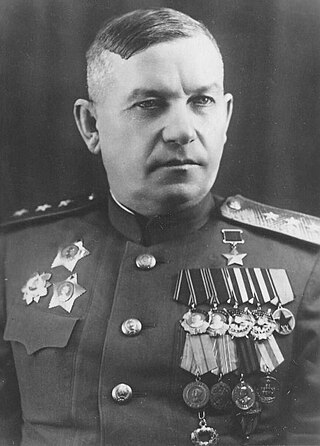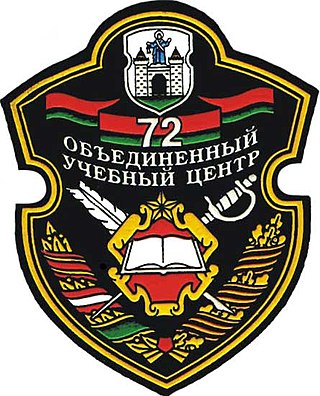The 75th Guards Rifle Division was a Red Army infantry division during World War II and afterwards, which later became the 75th Guards Tank Division and was finally disbanded in the 1990s.

The 20th Guards Combined Arms Army is a field army. In 1991, after the dissolution of the Soviet Union, the army became part of the Russian Ground Forces. Military Unit Number в/ч 89425.

The 97th Guards Mechanized Brigade was a rifle, and then a motor-rifle division of the Soviet Union's Army, before becoming a mechanized brigade of the Ukrainian Ground Forces, based in Slavuta in western Ukraine.

The 5th Guards Army was a Soviet Guards formation which fought in many critical actions during World War II under the command of General Aleksey Semenovich Zhadov. The 5th Guards Army was formed in spring 1943 from the 66th Army in recognition of that army's actions during the Battle of Stalingrad. The 5th Guards Army fought in the Battle of Kursk, Belgorod-Khar'kov Offensive Operation, Battle of the Dnieper, Uman–Botoșani Offensive, Lvov–Sandomierz Offensive, Vistula–Oder Offensive, Berlin Offensive, and the Prague Offensive. During the Berlin Offensive elements of the army linked up with American troops at Torgau on the Elbe. Postwar, the army was disbanded as part of the Central Group of Forces.
The 40th Guards Rifle Division was one of a series of ten Guards rifle divisions of the Red Army formed from airborne troops in the spring and summer of 1942 in preparation for, or in response to, the German summer offensive. It fought in the Stalingrad area during that battle, eventually in the operations that encircled German 6th Army, and then continued to serve in the several campaigns in the south sector of the front, helping to liberate Ukraine and the Balkans, and ending the war at Vienna.
The 9th Guards Army was a field army of the Red Army during World War II, which fought in the Vienna Offensive and the Prague Offensive at the end of the war. The army was formed in January 1945 and included airborne divisions converted into infantry. Postwar, the army headquarters became Soviet airborne headquarters.
The Soviet Airborne Troops formed a number of Airborne Corps during World War II.
The 2nd Guards Airborne Division was a division of the Red Army during World War II.
The 3rd Guards Airborne Division was a Red Army division of World War II. In December 1945 it appears to have become 125th Guards Rifle Division, while serving with 35th Guards Rifle Corps, 27th Army, Carpathian Military District.
The 6th Guards Airborne Division was a Red Army airborne division that fought as infantry during World War II.
The 8th Guards Airborne Division was an airborne division of the Red Army during World War II. On 27 December 1944, it was renamed the 107th Guards Rifle Division. It became the 107th Guards Airborne Division on 7 June 1946, before being disbanded in 1959.
The 10th Guards Airborne Division was an infantry division of the Red Army from 1942 to 1946.
The 105th Guards Airborne Division was an airborne division of the Soviet Airborne Troops.

Vasily Vasilyevich Glagolev was a Red Army Colonel general, Hero of the Soviet Union, and commander of the Soviet airborne (VDV). After initially serving in the Imperial Russian Army during World War I, Glagolev joined the Red Army in 1918. He rose to command the 42nd Cavalry Division on the Crimean Front in World War II, going on to command the 73rd and 176th Rifle Divisions as well as the 10th Guards Rifle Corps. Glagolev briefly became the commander of the 9th Army in February 1943 before being transferred to command of the 46th Army, which he would lead until May 1944. He became the 31st Army's commander and led it during the Vitebsk–Orsha Offensive. In January 1945, Glagolev commanded the 9th Guards Army, composed of Soviet airborne divisions converted into infantry. In April 1946, he became the commander of the Soviet airborne forces and died on in 1947 during exercises.
The 1st Airborne Corps was an airborne corps of the Red Army during World War II. It fought in the Battle of Kiev, the Battle of Moscow and in the Battle of Demyansk.
The 37th Guards Rechitsa, twice Red Banner, Orders of Suvorov, Kutuzov, and Bogdan Khmelnitsky Rifle Division was an infantry division of the Red Army which fought during World War II.
The 2nd Airborne Corps was a corps of the Red Army during World War II. It fought in the Battle of Kiev. In the summer of 1942, the 2nd Airborne Corps became the 32nd Guards Rifle Division.

The 72nd Guards Joint Training Centre is a training centre of the Belarus Armed Forces. It trains warrant officers and junior specialists for the Belarus Armed Forces and is based in Borisov. The 72nd Guards Joint Training Centre traces its history back to the Soviet 120th Rifle Division. For its actions during the Yelnya Offensive, the division became the 6th Guards Rifle Division in September 1941. In November 1945, the division became the 15th Guards Mechanized Division. On 15 May 1957, it became the 47th Guards Tank Division. The division became a training unit in 1960 and was renamed the 45th Guards Tank Training Division in 1965. In 1987, it became the 72nd Guards District Training Centre. In 1992, it was taken over by Belarus and became the 72nd Guards Joint Training Centre.
The 1st Guards Tank Division was a tank division of the Soviet Army from 1945 to 1947, stationed in Neuruppin. It was formed in the spring of 1942 as the 26th Tank Corps. The corps fought in Operation Uranus and became the 1st Guards Tank Corps, being redesignated as a reward for its actions in December 1942. It fought in Operation Gallop, the Third Battle of Kharkov, Operation Kutuzov, Operation Bagration, the East Prussian Offensive, the East Pomeranian Offensive and the Berlin Offensive. During the East Prussian Offensive, the division captured Mława, Działdowo and Płońsk and was awarded the Order of Lenin for its actions. The division had been awarded the honorific "Don" for its actions in Operation Gallop. It also was awarded the Order of the Red Banner and the Order of Suvorov 2nd class.
The 14th Guards Rifle Division was reformed as an elite infantry division of the Red Army in January, 1942, based on the 1st formation of the 96th Rifle Division, which was officially a mountain unit at the time, and served in that role until after the end of the Great Patriotic War. It was on Southern Front when it was redesignated and was soon assigned to the 57th Army. It was encircled during the May German counterattack in the Second Battle of Kharkov. Its first commander was made a prisoner of war, later dying in German captivity. A cadre of the division managed to escape and was sent to the Reserve of the Supreme High Command for rebuilding. In July it joined the 63rd Army and took part in the attacks against the Italian 8th Army that created the bridgehead south of the Don River near Serafimovich during August. In October, now in the 21st Army of Don Front, it was active in two probing attacks against the Romanian forces now containing the bridgehead which inflicted severe casualties in advance of the Soviet winter counteroffensive. At the start of that offensive the division was in 5th Tank Army, but was soon transferred to 1st Guards Army and then to the 3rd Guards Army when that was formed. It was under this Army as it advanced into the Donbas in late winter before returning to 57th Army during most of 1943, fighting through east Ukraine and across the lower Dniepr by the end of the year. After being briefly assigned to 53rd Army in December it was moved to 5th Guards Army in February, 1944 where it remained for the duration, mostly in the 33rd Guards Rifle Corps. It saw action in the Uman–Botoșani Offensive and won its first decoration, the Order of the Red Banner, as it advanced, before being involved in the frustrating battles along the Dniestr River on the Romanian border. In late spring, 1944 the division was redeployed north becoming part of 1st Ukrainian Front and taking part in the Lvov–Sandomierz Offensive into Poland. The 14th Guards made a spectacular advance across Poland during the Vistula-Oder Offensive and was awarded the Order of Lenin for its part in the liberation of Sandomierz. On January 22, 1945, its commander suffered mortal wounds in the fighting for a bridgehead over the Oder River. In the drive on Berlin in April the division and its regiments won further honors and decorations but despite these distinctions it was disbanded in August, 1946.




